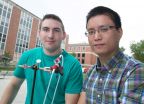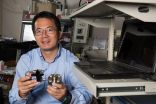(Press-News.org) COLUMBUS, Ohio--After debuting the world's first solar air battery last fall, researchers at The Ohio State University have now reached a new milestone.
In the Journal of the American Chemical Society, they report that their patent-pending design--which combines a solar cell and a battery into a single device--now achieves a 20 percent energy savings over traditional lithium-iodine batteries.
The 20 percent comes from sunlight, which is captured by a unique solar panel on top of the battery, explained Yiying Wu, professor of chemistry and biochemistry at Ohio State.
The solar panel is now a solid sheet, rather than a mesh as in the previous design. Another key difference comes from the use of a water-based electrolyte inside the battery.
Because water circulates inside it, the new design belongs to an emerging class of batteries called aqueous flow batteries.
"The truly important innovation here is that we've successfully demonstrated aqueous flow inside our solar battery," Wu said.
As such, it is the first aqueous flow battery with solar capability. Or, as Wu and his team have dubbed it, the first "aqueous solar flow battery."
"It's also totally compatible with current battery technology, very easy to integrate with existing technology, environmentally friendly and easy to maintain," he added.
Researchers around the world are working to develop aqueous flow batteries because they could theoretically provide affordable power grid-level energy storage someday.
The solar flow battery could thus bridge a gap between today's energy grid and sources of renewable energy.
"This solar flow battery design can potentially be applied for grid-scale solar energy conversion and storage, as well as producing 'electrolyte fuels' that might be used to power future electric vehicles," said Mingzhe Yu, lead author of the paper and a doctoral student at Ohio State.
Previously, Yu designed the solar panel out of titanium mesh, so that air could pass through to the battery. But the new aqueous flow battery doesn't need air to function, so the solar panel is now a solid sheet.
The solar panel is called a dye-sensitized solar cell, because the researchers use a red dye to tune the wavelength of light it captures and converts to electrons. Those electrons then supplement the voltage stored in the lithium-anode portion of the solar battery.
Something has to carry electrons from the solar cell into the battery, however, and that's where the electrolyte comes in. A liquid electrolyte is typically part salt, part solvent; previously, the researchers used the salt lithium perchlorate mixed with the organic solvent dimethyl sulfoxide. Now they are using lithium iodide as the salt, and water as the solvent. (Water is an inorganic solvent, and an eco-friendly one. And lithium iodide offers a high-energy storage capacity with low cost.)
In tests, the researchers compared the solar flow battery's performance to that of a typical lithium-iodine battery. They charged and discharged the batteries 25 times. Each time, both batteries discharged around 3.3 volts.
The difference was that the solar flow battery could produce the same output with less charging. The typical battery had to be charged to 3.6 volts to discharge 3.3 volts. The solar flow battery was charged to only 2.9 volts, because the solar panel made up the difference. That's an energy savings of nearly 20 percent.
The project is still ongoing, and the solar flow design will undoubtedly evolve again as the researchers try to make the battery more efficient.
Doctoral student and study co-author Billy McCulloch said that there are many different directions the research could take.
"We hope to motivate the research community to further develop this technology into a practical renewable energy solution," he added.
The team's ultimate goal is to boost the solar cell's contribution to the battery past its current 20 percent--maybe even to 100 percent.
"That's our next step," Wu said, "to really achieve a fully solar-chargeable battery."
INFORMATION:
Other coauthors on the paper included doctoral students Damian R. Beauchamp, Zhongjie Huang and Xiaodi Ren.
This research was funded by the Department of Energy.
Yiying Wu, (614) 247-7810; Wu.531@osu.edu [Wu is currently on sabbatical at Argonne National Laboratory and is best reached by email.]
Written by Pam Frost Gorder, (614) 292-9475; Gorder.1@osu.edu
CLAREMONT, Calif. -- Conventional theories used by economists for the past 150 years to explain how societies buy, sell, and trade goods and services may be able to unlock mysteries about the behavior of microbial life on earth, according to a study by researchers from Claremont Graduate University, Boston University, and Columbia University.
The findings, published July 29 in the open access journal PLOS ONE, provide new insight into the behavior of the planet's oldest and tiniest life forms, and also create a new framework for examining larger questions about biological ...
Resettlement projects in the Amazon are driving severe tropical deforestation - according to new research from the University of East Anglia and Câmara dos Deputados (the Brazilian Lower House).
Widely hailed as a socially responsible and 'innocuous' strategy of land redistribution, agrarian reform settlements have been created throughout the Brazilian Amazon since the early 1970s at an unprecedented scale.
But a study published today in PLOS ONE reveals that these farmer resettlement projects are far from environmentally friendly or socio-economically beneficial. ...
Tempe, Ariz. -- When it comes to vaccinating their babies, bees don't have a choice -- they naturally immunize their offspring against specific diseases found in their environments. And now for the first time, scientists have discovered how they do it.
Researchers from Arizona State University, University of Helsinki, University of Jyväskylä and Norwegian University of Life Sciences made the discovery after studying a bee blood protein called vitellogenin. The scientists found that this protein plays a critical, but previously unknown role in providing bee babies ...
Precise targeting biological molecules, such as cancer cells, for treatment is a challenge, due to their sheer size. Now ,Taiwanese scientists have proposed an advanced solution, based on a novel combination of previously used techniques, which can potentially be applied to thermal cancer therapy. Pei-Chang Tsai from the Institute of Atomic and Molecular Sciences, at the Academia Sinica, Taipei, and colleagues just published in EPJ QT an improved sensing technique for nanometre-scale heating and temperature sensing. Using a chemical method to attach gold nanorods to the ...
New research in mice shows that two commonly used gout medications, which target uric acid and adenosine triphosphate, may offer protection from alcohol-induced liver disease and inflammation. These findings suggest that clinical trials in humans with alcoholic liver disease should be considered. The report appears in the August 2015 issue of the Journal of Leukocyte Biology.
"This study should ultimately help patients with alcoholic liver disease to prevent and/or treat acute episodes of alcoholic hepatitis, a potentially lethal condition," said Gyongyi Szabo, M.D., ...
New research by scientists at the University of York has given tea and coffee drinkers new information about why their favourite drinks taste as they do.
The study led by Dr Seishi Shimizu, of the York Structural Biology Laboratory in the University's Department of Chemistry, shows that sugar has an important effect in reducing the bitterness of tea and coffee, not just by masking it but by influencing the fundamental chemistry.
The research published in Food and Function reveals new insights into the way in which caffeine, sugar and water interact at the molecular ...
While all human organs undergo normal, chronological aging, human skin undergoes an additional type of aging because of its direct contact with the environment. The environmental factor that ages human skin more than any other is UV radiation (UVR) from the sun, a process is called photoaging. Unlike chronological aging, which occurs exclusively with the passage of time, photoaging occurs when skin is repeatedly exposed to UV radiation from the sun.
Over time, the sun's ultraviolet (UV) light damages the fibers in the skin called elastin. When these fibers break down, ...
A synthetic membrane that self assembles and is easily produced may lead to better gas separation, water purification, drug delivery and DNA recognition, according to an international team of researchers.
This biomimetic membrane is composed of lipids -- fat molecules -- and protein-appended molecules that form water channels that transfer water at the rate of natural membranes, and self-assembles into 2-dimensional structures with parallel channels.
"Nature does things very efficiently and transport proteins are amazing machines present in biological membranes," said ...
Concerns about perfectionism can sabotage success at work, school or on the playing field, leading to stress, burnout and potential health problems, according to new research published by the Society for Personality and Social Psychology.
In the first meta-analysis of the relationship between perfectionism and burnout, researchers analyzed the findings from 43 previous studies conducted over the past 20 years. It turns out perfectionism isn't all bad. One aspect of perfectionism called "perfectionistic strivings" involves the setting of high personal standards and ...
(Boston)--A new way to detect - and perhaps treat - one of the deadliest types of breast cancer has been found.
Led by researchers at Boston University School of Medicine (BUSM), the study appears online in Breast Cancer Research.
Basal-like breast cancer (BLBC) is an aggressive form of breast cancer and is often referred to as "triple negative," which means it is not responsive to the common medical therapeutics. BLBC is more likely to metastasize - or spread to different areas of the body - quicker and earlier, and is associated with a poor prognosis. Women younger ...



